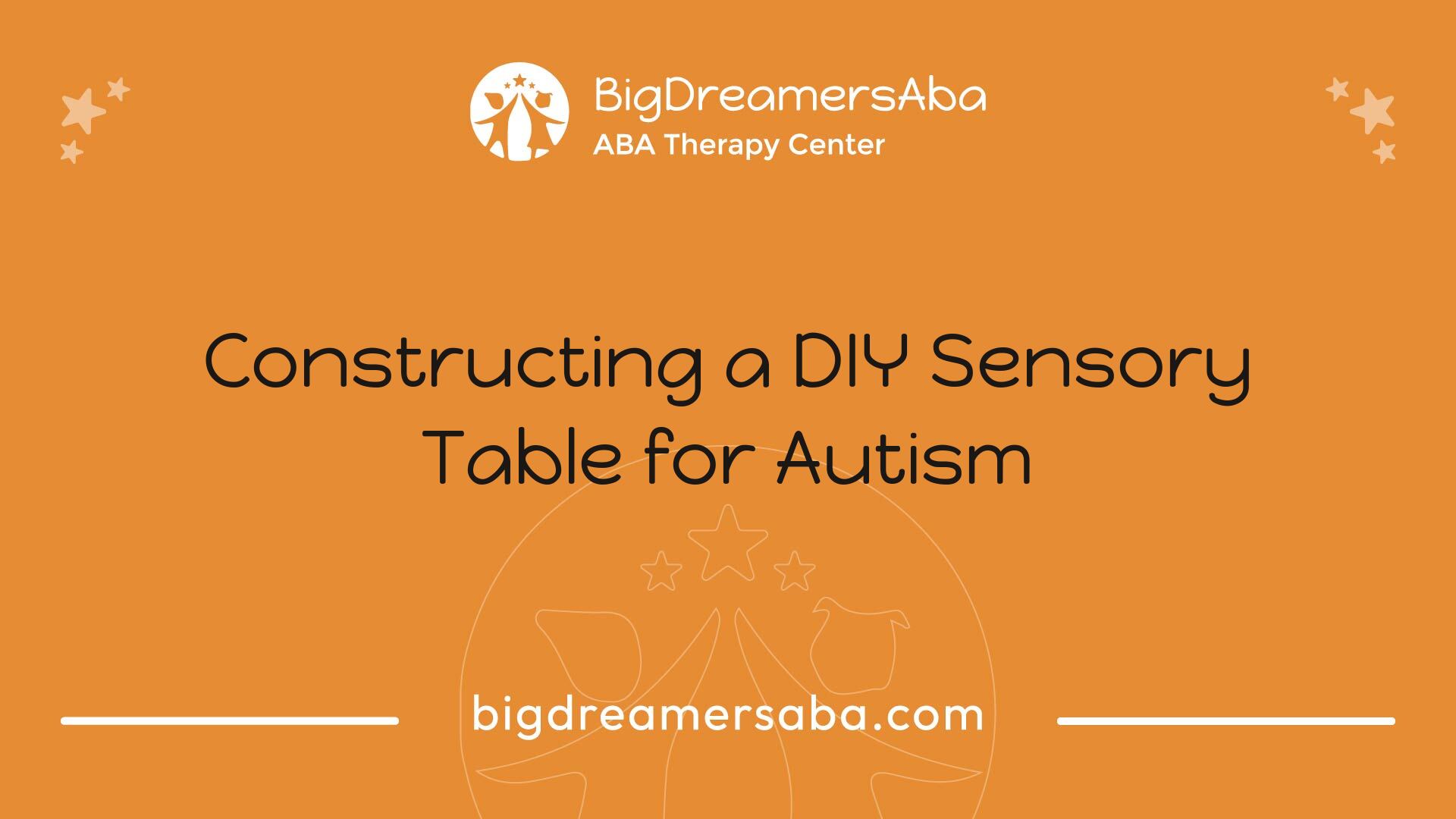Enhancing Skills with Sensory Table for Autism
Discover how a sensory table for autism enhances skills and supports sensory exploration for joyful playtime.


Sensory Activities for Autism
Understanding Sensory Exploration
Sensory exploration is a critical aspect of development for children with autism. Engaging in sensory activities allows them to learn about their bodies and how they relate to their environment. These activities provide opportunities to interact with different textures, sounds, and visual stimuli, which can enhance their understanding of the world around them. Sensory tables, in particular, create a structured and controlled setting for individuals with autism to explore various materials, fostering cognitive and physical development [1].
Sensory ActivityPurposeTextured MaterialsEnhance tactile sensitivityWater PlayUnderstanding fluid dynamicsSand PlayEncourage creativity and fine motor skills
Importance of Sensory Play
Sensory play is essential for children with autism as it supports their overall development and well-being. Engaging with sensory tables or similar activities provides hands-on experiences that aid in learning, problem-solving, and creativity. Children can refine their conversational skills as they interact with peers during these activities, learning to communicate their thoughts and feelings more effectively. It also helps them understand cause and effect relationships, such as observing how sand behaves when wet or discovering the different capacities of scoops.
Sensory activities help manage sensory responses, providing a safe environment where children can adapt to various stimuli. This controlled exposure promotes a balanced sensory experience, helping manage challenges related to sensory overload. As children engage in these activities, they also enhance their fine and gross motor skills, improving coordination and boosting their confidence [3].
For further insights into the advantages of sensory play, consider exploring our articles on benefits of sensory toys and understanding sensory processing issues in autism.

Types of Sensory Tables
Sensory tables provide engaging opportunities for children with autism to explore their senses. Different types of sensory tables focus on various skills and experiences, enhancing development and interaction.
Water Tables for Fine Motor Skills
Water tables are excellent tools for enhancing fine motor skills in children with autism. Activities such as pouring water, navigating balls through obstacles, and experimenting with floating and sinking objects help improve hand-eye coordination and sensory integration. Children can grasp, squeeze, and release different toys and tools, fostering their dexterity and coordination [1].
ActivitySkills DevelopedPouring waterHand-eye coordination, grip controlNavigating ballsSpatial awareness, problem-solvingFloating objectsExploration, sensory awareness
Sand Tables for Tactile Sensations
Sand tables provide tactile sensations and promote creativity in children with autism. They engage children through digging, scooping, and molding sand, which aids in developing fine motor skills. These sensory tables also create opportunities for social interactions as children engage with siblings or peers during play.
ActivitySkills DevelopedDigging and scoopingFine motor skills, strengthMoldable shapesCreativity, sensory explorationSocial interactionsCommunication, cooperation
Moon Dough Tables for Creativity
Creating a moon dough table is a delightful sensory experience for children with autism. Moon dough, made from flour and baby oil, is moldable and encourages creativity and fine motor skill development. The tactile nature of the moon dough allows children to experiment with shapes and forms, further stimulating their sensory exploration [1].
ActivitySkills DevelopedMolding and shapingFine motor skills, imaginationTexture explorationSensory awareness, creativity
Each type of sensory table serves a unique purpose, catering to various developmental needs in children with autism. By incorporating these engaging activities into playtime, caregivers can support skill development and sensory exploration. For more ideas on creating engaging activities, visit sensory table ideas for autism.

Benefits of Sensory Tables
Sensory tables offer numerous advantages for children with autism, facilitating critical development in various areas. This section highlights the developmental aspects, social interaction opportunities, and emotional regulation benefits that sensory tables provide.
Developmental Aspects
Sensory tables are instrumental in promoting fine motor skills, language development, and hands-on exploration. Children engaging with these tables learn to problem-solve, develop creativity, and refine their conversational skills. For instance, through activities such as pouring sand or manipulating various objects, children can understand cause and effect relationships, such as seeing what happens to sand when it gets wet [2].
The following table outlines key developmental areas enhanced by sensory tables:
Developmental SkillDescriptionFine Motor SkillsEnhances hand-eye coordination through activities like pouring and scooping.Language DevelopmentEncourages vocabulary building during guided play and interaction.Problem-SolvingAllows children to explore solutions by manipulating materials.CreativityFosters imaginative play by providing varied sensory experiences.
Social Interaction Opportunities
Sensory tables can serve as a hub for social interactions among children. When children engage with a sensory table together, they have the opportunity to share experiences, negotiate play, and communicate their ideas and findings. These interactions can significantly enhance their social skills, even among those who may not verbally communicate easily. Sensory tables create a non-threatening environment that encourages children to work together and engage in cooperative play.
Key social interaction benefits include:
Emotional Regulation Benefits
Engaging with sensory tables also contributes to emotional regulation. The activities provided by sensory tables create a calming and predictable environment, essential for those with autism. Research indicates that sensory activities can help reduce anxiety and provide a therapeutic outlet for emotional expression.
Sensory tables allow children to experience soothing sounds, gentle movements, or comforting textures that enhance emotional well-being. By helping individuals manage their emotions effectively, sensory tables become an invaluable tool for emotional development.
Table of emotional regulation benefits:
Emotional BenefitDescriptionAnxiety ReductionHelps to calm individuals through engaging sensory experiences.Expressions of EmotionProvides safe outlets for emotional expression through play.Predictable EnvironmentOffers routines and predictability that foster a sense of security.
In summary, the benefits of sensory tables for autism encompass crucial developmental aspects, social interaction opportunities, and emotional regulation, making them an essential resource in supporting children with autism. For further insights on sensory activities, explore sensory toys for autism and diy sensory table for autism.

Creating a DIY Sensory Table
Creating a sensory table for autism can provide a valuable avenue for sensory exploration and skill enhancement. Sensory tables offer structured and controlled spaces where individuals can interact with various sensory materials, fostering overall development and well-being.
Home-Based Sensory Exploration
A DIY sensory table does not need extensive materials or complexity; it can be easily assembled at home. This type of table typically consists of a low table that holds one or more containers filled with different mediums such as sand, water, or dried pasta. Additional items like buttons, scoops, and sponges can be included to enrich the experience. Children can investigate various textures, weights, and colors through sensory play, which can help them learn and process their environments [2].
This hands-on experience provides opportunities to explore cause and effect relationships, such as understanding how the weight of wet sand varies compared to dry sand. Parents or caregivers can enhance the learning experience by engaging with children during sensory activities, reinforcing safety and guidance.
Safe Materials and Mediums
When setting up a DIY sensory table, it is crucial to choose safe materials and mediums that are appropriate for children, especially those with autism. Below are some suitable options:
Medium TypeExampleBenefitsDry MediumsSand, Dried PastaEncourages tactile exploration and fine motor skills.Wet MediumsWater, Foam, GelProvides sensory experiences through splashing and sensory interactions.Moldable MediumsMoon Dough (made from flour & baby oil)Fosters creativity and fine motor skill development.
In creating a sensory table, it is important to ensure that all materials are non-toxic and age-appropriate. Incorporating a mix of mediums can enhance the sensory experience and cater to the specific preferences and needs of the individual. For additional ideas and inspiration, check out our article on sensory table ideas for autism.
DIY sensory tables serve as an excellent tool for promoting skills like problem-solving, creativity, and social interaction. They not only provide meaningful sensory experiences but also encourage children with autism to engage with their surroundings in a safe and controlled manner.

Sensory Integration Theory
Addressing Sensory Challenges
Sensory integration theory, as developed by A. Jean Ayres, emphasizes the importance of tailored sensory experiences for children with Autism Spectrum Disorders (ASD). This approach recognizes that many children with ASD experience sensory processing issues, which can manifest as difficulties in responding appropriately to sensory input NCBI. The prevalence of sensory processing disorder (SPD) in children with autism ranges from 42% to 88% in various studies, indicating a significant need for effective interventions.
By focusing on controlled sensory experiences, sensory integration therapies aim to help children develop adaptive motor responses. These interventions are structured to meet the individual needs of each child, promoting engagement and interaction during sensory activities. This tailored approach is crucial in addressing the unique sensory challenges faced by each child, ultimately enhancing their overall daily functioning and participation in various activities.
Positive Impact on Behavior
Implementing sensory integration interventions can have a profound positive impact on behaviors associated with ASD. A systematic review of Ayres Sensory Integration (ASI) interventions has shown promising results, demonstrating its effectiveness as an evidence-based practice for children aged 4–12 years NCBI. ASI is designed to be individualized, promoting a collaborative relationship between the child and therapist, which is essential in helping children navigate their sensory challenges.
By engaging in sensory-rich activities, children can learn to regulate their emotional responses and behaviors better. For instance, sensory tables can provide opportunities for positive play experiences, reducing anxiety and frustration levels. This approach not only supports emotional regulation but also fosters social interaction, enhancing communication and relationship-building skills. As children engage with their sensory environment, they become more adept at managing sensory overload, ultimately leading to improved behavior in various settings.
Integrating sensory play into daily routines can also help in addressing behaviors related to sensory seeking or sensory aversion, allowing children to find a balance that suits their individual needs. By recognizing the significance of sensory integration theory and its applications, caregivers and professionals can create an environment that enriches the sensory experiences of children with autism, aiding their overall development. For further insights on implementing sensory experiences, check related topics like creating a sensory-friendly environment and managing sensory overload in autism.
Sensory Bins and ASI Interventions
Stimulating Sensory Experiences
Sensory bins are a practical tool in enhancing sensory experiences for children with autism. These bins are filled with materials that engage multiple senses, providing tactile, visual, and even olfactory stimulation. Constructing sensory bins allows for controlled exploration, which is crucial for children who may struggle with sensory overload.
The stimuli in sensory bins can be tailored to individual preferences and sensitivities. Examples of materials include sand, water beads, rice, and even fabric. These various textures help encourage fine motor skills and promote sensory integration, which is essential in developing a child's ability to process sensory information effectively.
MaterialSensory ExperienceBenefitsSandTactileEnhances fine motor skillsWater BeadsTextured, slipperyCalming effectsRiceCrunchy, granularImproves hand-eye coordinationFabricSoft, varied texturesEncourages creative play
Evidence-Based Practice for Autism
Research supports the effectiveness of Ayres Sensory Integration (ASI) as an intervention for children with autism. ASI is based on sensory integration theory and focuses on providing structured sensory experiences to elicit positive behavior changes. Through individualized and collaborative approaches, ASI helps address underlying sensory-motor difficulties impacting daily routines and activities.
Evidence from controlled trials indicates that ASI interventions yield meaningful outcomes for children with ASD. For instance, a study by Pfeiffer et al. (2011) demonstrated that children receiving ASI exhibited greater improvements in specific goals and a noticeable decrease in autism mannerisms when measured against the Social Responsiveness Scale (SRS).
Furthermore, systematic reviews have recognized ASI as an evidence-based practice for children aged 4-12 years old, meeting established criteria in multiple randomized controlled trials. By incorporating sensory bins into a broader ASI framework, caregivers and educators can create engaging, effective learning environments tailored to the needs of children with autism.
Utilizing sensory activities not only fosters playful exploration but also supports broader developmental goals, making it an integral approach in working with children on the autism spectrum. For more insights on sensory tools, explore our articles on sensory toys for autism and calming sensory room ideas for autism.
References
[2]:
[3]:
[4]:
[5]:
Recent articles

Making Morning Time Stress Free for Kids With ABA Therapy

How ABA Programs Help Kids With Autism Develop Social Understanding
.jpg)